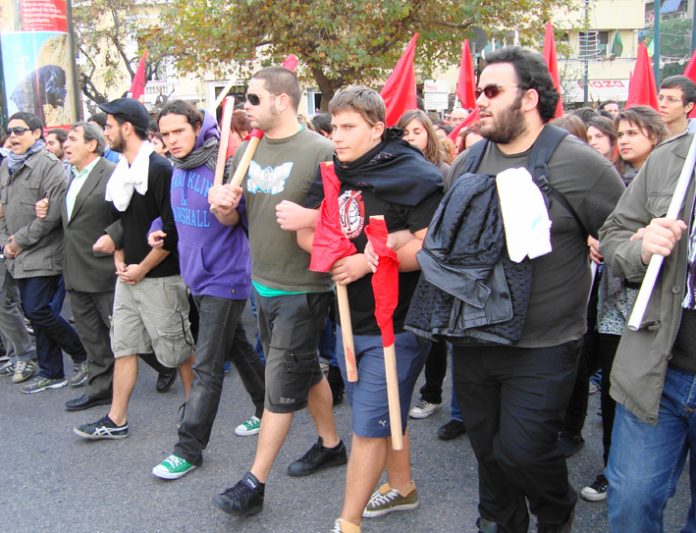SOME 15,000 students, youths, workers and trade unionists marched on Sunday afternoon from Athens Polytechnic to the Greek police HQ in protest against the cold-blooded murder of a 15-years old school student by a Greek police Special Guard last Saturday night.
The demonstration was organised by the Committee for the Defence of Constitutional Rights, and supported by the Coalition of the Left party and several left-wing organisations.
Thousands more took part in rallies and marches in Salonica and several other Greek cities.
The Greek Communist Party (KKE) did not participate in the marches but they were due to hold their own protest rally yesterday evening (Monday December 8th). The Coalition of the Left were also to hold a rally last night but in a different place.
The GSEE (Greek TUC) leaders did not even bother to issue a condemning statement despite the fact that they are the organisers of a general strike this Wednesday against government policies.
Eye-witness Fondas Papadimitriou said that he saw a Special Guard firing from a distance of some 50 yards at a group of about 30 youths who were on a night out.
Papadimitriou stated that the shooting followed an exchange of shouts and abuse – at a distance – between two Special Guards and the youths.
Other eye-witnesses stated that the two Special Guards had parked their police car around a corner and walked back towards the youths, following a short exchange of abuse, always from a distance,
One of the Special Guards fired straight into the youths.
Then they calmly walked away to the police car and drove off.
In their statement to the police authorities investigating the murder, the two Special Guards claimed that one of them fired three shots; two in the air and a third on the ground.
According to the Special Guards the third bullet bounced off the pavement and hit the 15-years old boy on the chest.
On Sunday the two Special Guards appeared before the Public Prosecutor who charged the 37-years old policeman who shot the youth with premeditated murder and illegal use of a firearm; while the other was charged with accessory to murder.
Greek police have not released the names of the two Special Guards.
Following the school student’s murder, many thousands of students and youths demonstrated spontaneously throughout Saturday night in Athens, Salonica and in all university cities in Greece.
The armed special police units attacked the demonstrators using unlimited quantities of tear-gas canisters and stun grenades.
Rioting followed with attacks on banks, cars salerooms, large department stores and police stations.
Some twenty cars and many plastic rubbish bins were set ablase as so-called ‘anarchist’ and ‘anti-state’ youths and university students set up road barricades in Athens, Salonica and Patras.
They were fiercely attacked throughout Saturday night by police with tear-gas.
The angry march in Athens on Sunday afternoon was dominated by banners and chanting against the ‘government of murderers’.
Several banners called for the overthrow of the right-wing government of prime minister Kostas Karamanlis.
There were also demands to disband the Special Guards corps and to ban police from carrying firearms.
Large delegations of primary and secondary school teachers and university lecturers also took part in the demonstration.
As the march made its way towards the Greek Police HQ, about two miles away from the Athens Polytechnic, scores of youths moved to the flanks of the demonstration.
They and the armed special police units stationed on the side streets started taunting each other.
The youths threw stones at the police and they retaliated immediately with liberal use of tear-gas canisters thrown straight into the main body of the demonstration.
Rubbish bins were set on fire and several banks and hotels’ windows were smashed. Two car salesrooms were set on fire.
The special police units intensified their attacks on the front, middle and tail of the demonstration by throwing literally hundreds of stun bombs and tear-gas canisters.
Thousands of demonstrators ran to the side streets to avoid the tear-gas.
But the bulk of the march remained disciplined and marched towards the Greek Police HQ to find that dozens of police buses and many police blocked the way.
By now the whole area had been turned into a battlefield with thick clouds of smoke and tear-gas and street barricades.
Then a few thousand students marched to the Vouli building (Greek parliament).
But they too were confronted by hundreds of armed special police and scores of buses who blocked the way.
Once again, the police attacked the students with stun grenades and tear-gas.
Then the police charged with their long batons hitting anyone on sight.
The students marched to the Polytechnic and to other university buildings to seek refuge.
Then, – not seen before – armed police units dressed in all-black paramilitary uniforms appeared and collaborated with the special police units in attacking demonstrators and passers-by.
By early Sunday evening a large part of the Athens city centre became cordoned off by police.
Students and youth set up barricades outside the Polytechnic and other University of Athens buildings to stop possible police raids.
Late on Sunday an Athens hospital spokesperson said that there have been 11 people injured by the police attacks who are receiving treatment.
The three most serious cases were a woman with head injuries and two youths with injuries in their backs caused by police baton-blows.
The police announced that seven arrested youths were to appear in court charged with looting.
There were also several injuries and arrests of demonstrators in a number of Greek cities on Sunday evening.
In Salonica, Patras and Iraklio on the island of Crete, police stations were attacked by petrol bombs.
POSDEP (university lecturers’ trade union) announced a three-day strike and all universities and technical colleges in Athens, Piraeus and Salonica will remain closed until Thursday.
Students and lecturers called for mass participation on this Wednesday’s general strike and demonstration.
